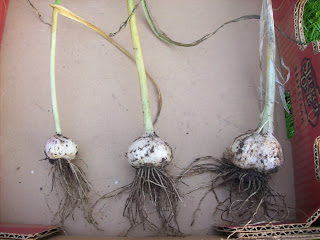Today I harvested all of the potatoes at home. These were all the potatoes that I grew in straw. In the bottom bed I had 12 plants of River john blue to uncover. They were planted in a trench and covered with approximately 6 inches of straw.
While the plants were growing they were not supported properly and the stalked all fell over. The straw was very easy to take off and most of the potatoes were just sitting there waiting to be picked up.
There were a number of potatoes that were mostly buried in the ground so after I picked all of the ones that I could see, I took the fork and dug where they had been planted. Of all the potatoes from the row approximately 10% of them I found with the fork afterward. There was a good mix of sizes with most being medium to large.
The black Macintosh was planted in these 2 boxes. Between them I had 10 plants (6 and 4). One box was planted with the potatoes in the soil with a little bit of straw and the other was planted on the soil with approximately 8 inches of straw. The 2 boxes even though they had a different number of plants both produced about the same. The potatoes were small to medium sized, nothing very big.
The banana fingerling potatoes that were harvested today were also planted in a box. They were covered with approximately 4 inches of straw. I was actually pleasantly surprised at how well they did. After removing the straw I was able to pick up 60% of the potatoes without doing any digging. And the remainder I just dug up with my hands because they were in the box in an uncompact soil. Because these are fingerlings they are naturally small, and I had a wide variety of sizes with an overall decent quantity.


Overall I am very happy with the straw and box experiments. The straw led to cleaner and easy to dig potatoes. I would defiantly use straw again. I might use boxes again. The only drawback to the boxes is the size of your potatoes. All of the potatoes I planted in boxes I also planted in the bottom garden bed in the traditional method. Consistently across all 3 varieties the potatoes planted in the garden were larger than those in boxes. The potatoes in the boxes were cleaner and do not appear to have any scab on them.
This morning I also spent 3 hours helping to rake leaves at the cottage. I am planning on using these leaves for mulching purposes this fall and in the garden next year. I brought home a full truck load (approx. 600lb) and there are probably 3-4 times as many more still there. I will most likely get a few more this fall and then get the rest next summer.





















































